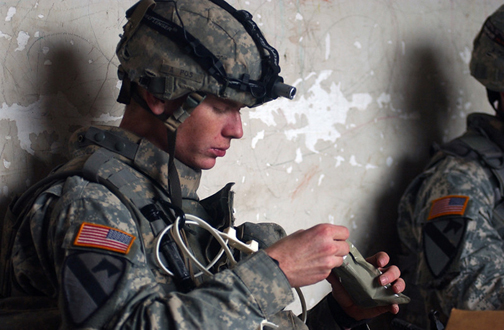Researchers reduce waste and improve taste with the 'First Strike Ration'
Researchers are constantly searching for new and tastier ways to improve military rations. Thanks to modern science and the availability of state-of-the-art packaging, researchers are able to more easily feed deployed troops with food that not only lasts longer, but also tastes better.
The U.S. Army Research Institute of Environmental Medicine, part of the U.S. Army Medical Research and Materiel Command at Fort Detrick, Md., functions as a world-class laboratory for environmental medicine, physiology, physical and cognitive performance, and nutrition research. Its mission: To protect, sustain, and enhance warfighter health and performance. Within the USARIEM lies the Military Nutrition Division, a research area tasked with the responsibility of defining nutritional standards for operational rations as well as developing nutritional strategies to support and enhance military performance during sustained operations in extreme environments.
From the Department of Defense Combat Feeding Directorate at Natick Soldier Systems Center in Natick, Mass., which is tasked with the development of rations for not only Army Soldiers, but also Marines, Airmen and Sailors alike, came the nutritionally optimized, eat-on-the-move First Strike Ration currently being used in the field. This collaborative effort between the Combat Feeding Directorate and the USARIEM was nominated for the Collaboration Award at the 2006 Research and Development Lab of the Year awards. The objective: a nutritionally optimized ration designed to maximize the nutritional and functional capabilities of the new assault-type ration, called the First Strike Ration.
First fielded in 2008, this high-energy FSR, or "assault ration," is intended for use in the first 72 hours of operations by forward-deployed troops. Serving as a replacement for three daily Meal-Ready-to-Eat rations, the FSR contains fewer calories, more carbohydrates, less packaging, and best of all, requires no preparation at all.
"The actual First Strike Ration is a specific combination of foods in the actual ration that maximizes Soldier nutrition with limited resources," said Dr. Valerie Trabosh, senior scientist and manager of the Physiological Health Portfolio within the Military Operational Medicine Research Program. "The main theory behind the FSR was: 'If a Soldier can only eat a small amount of food, what is the best combination of nutrients that should be consumed to maintain optimal performance.'"
Researchers have long been challenged by the need to provide Soldiers in the field with food that is nutritious, palatable, and nonperishable. Soldiers in combat operations do not always have the luxury of enjoying a sit-down meal, so it is essential that they are provided functional, compact, eat-on-the-move rations that are not only designed specifically to fuel their bodies quickly and effectively, but that also taste good.
Today's individual field rations continue to benefit from ongoing research efforts, with many popular improvements including greater variety and even vegetarian options. The FSR menu expanded from three to nine menus in 2012 alone, introducing more than 40 new menu items.
"The researchers at NSRDEC [Natick Soldier Research, Development, and Engineering Center] and USARIEM are constantly exploring new things that can be introduced into the military rations that would benefit the Soldier," said Trabosh. "The ration program is more important than ever," and "it is imperative to understand the ever-changing nutritional needs of Soldiers in various operational environments. Without proper energy sources, Soldiers will not be performing at their best to complete each mission successfully."
As the saying goes, "we are what we eat," and the operational success of our military depends greatly on the nutritional practices and healthy eating habits of our Soldiers.















